The date of the Scottish Independence Referendum is near. On 18 September 2014, people will be able to say whether or not they want Scotland to be an independent country.
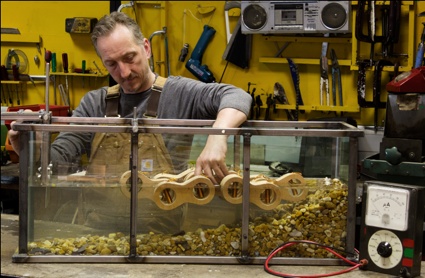
 Prototype wave machine2. Photographer – Lou-Atessa Marcellin
Prototype wave machine2. Photographer – Lou-Atessa Marcellin
A New Scottish Enlightenment, Mohammed J. Ali’s Design Interactions graduation project, goes back to 1979 (the year of the Scottish devolution referendum which invited citizens to vote in support for a devolved deliberative assembly) to imagine what could have happened if the Scottish Independence Referendum had actually taken place 35 years ago and people had voted in favour of it.
Ali’s counterfactual speculation proposes that the positive outcome for the referendum leads to the creation of the New Scottish Government. Scotland is a place known for its inventiveness and the independence invigorates the nation’s creative spirit. A key policy of the government is to help citizen achieve personal energy independence, paving the way for a future liberated from the reliance of fossil fuels. The measure sees the prototyping of DIY energy generating machines, the re-purposing of abandoned coal mines, and even the discovery of the first self-sustaining fusion reaction. Furthermore, the success of the energy policy leads to the creation of alternative economic paradigms where different forms of exchange and economy are created based on distribution and sharing of energy.
The work A New Scottish Enlightenment describe the outcomes of some of the key pieces of legislation either on an individual, community or global level.
Timeline for New Scotland
A few questions to Mohammed J. Ali:
Hi Mohammed! The events you chart make our own present look extremely backwards. Why is your project located in counterfactual speculation rather than directly in an unspecified future?
One of the reasons I wanted to examine a counterfactual Scotland, was because on 18th September this year, there is a referendum for independence. There was a similar referendum in 1979 for a devolved government. Then, despite a Yes result of almost 52%, Scotland didn’t eventually become independent. An addition to the Scotland Act 1978 stipulated that 40% of the entire voting public had to vote in favour. If that had actually happened, Scotland could have become an independent country. It’s a bit more complicated, with a bit more politics than this but it all adds a layer of reality which would have been lost if I’d positioned it in another time/place.
In a twist to the real events, I propose Scotland actually becomes independent in 1979. We can then begin to imagine what might have happened given what we know has happened since then. An alternative Scotland is a way of perhaps holding a mirror to what could potentially happen after September 18th this year. The world might suddenly start to become a very different place.
I also wanted to look at what might happen to a modern, developed country which becomes independent, a unique event in modern times. The legislative, social and economic models of its former political partner/leader are replaced by those more sympathetic to the ideals of the new state. Scotland has historically been socialist, certainly left leaning; the map often turning red (the colour of the Labour Party) during general elections.
Perhaps one of the reasons why our current reality might look backwards in comparison to that in the counterfactual is because I imagined a country emboldened by independence and willing to try more extraordinary measures to bring individual independence to its people. I wanted to take advantage of the boom in research into alternative energy technologies which was happening during the seventies and early eighties resulting from an over-dependence on oil, coal and gas reserves mainly held by a minority of overseas nations.
The reality is that in the eighties, global research funding into renewable energy technologies was cut, as a result of the steady drop in the price of oil and its increased availability. I wanted to conceive a progressive nation where there was a realisation that energy was always a key component in humanity’s evolution and that the current sources of energy were simply a staging post in the progress towards the next (hopefully better) one.
The Acts of Parliament of the New Scottish Government were simply tools to enable this to happen – think of Jimmy Carters National Energy Act 1978 and the later Energy Policy Acts in the US. The Legislative Acts in the speculation “A New Scottish Enlightenment” have some basis in the real world, from where they could be drafted into the speculation.
Important technological events such as the introduction of Napster in the late 90s meant that I could draw on peer-to-peer file sharing as a means of creating an analogue in New Scotland where surplus energy could be transmitted across a conjoined energy and information network.
The key was the creation of a country with the potential to be a blank canvas onto which I could paint a picture describing potential futures. In this respect Scotland was the perfect example. We don’t know its future, but we can examine its past and describe the potentials of what might have been.
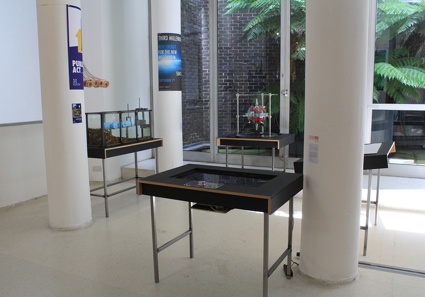 Installation RCA June 2014. Photographer – Mohammed J Ali
Installation RCA June 2014. Photographer – Mohammed J Ali
Energy is a highly lucrative business. Why would a state (and the corporations that are closely linked to any government) have any interest in leaving it into the hands of the people?
The UK energy production and distribution sector were centrally controlled until the privatisation of the electricity and gas markets from the mid-80s. Historical precedents suggest that this new state could also have created a nationalised oil infrastructure similar to Iran’s in 1951, which happened despite fierce British opposition, or Iraq’s in 1972 to name but two. However, New Scotland continues to receive revenue in the form of taxation from oil production which it accumulates into a Sovereign Wealth Fund. This is used to ultimately make the people of New Scotland independent, in energy terms, through the creation of their personal energy infrastructures.
In your scenario, the New Scottish Government’s first act is to create a sovereign wealth fund with the proceeds of North Sea Oil. What is this fund exactly?
Sovereign Wealth Funds are often the accumulated capital received from the tax receipts of oil production. They are usually invested in a portfolio of real or financial assets to enable them to grow. New Scotland as a result of independence would inherit the oil reserves within its national coastal boundary. It follows a Norwegian model by creating a fund to enable future projects or to be used in times of need.
The New Scottish Government decides to begin investment in energy infrastructures from 1985, which coincides with the period in which actual receipts from oil revenues were at their greatest.
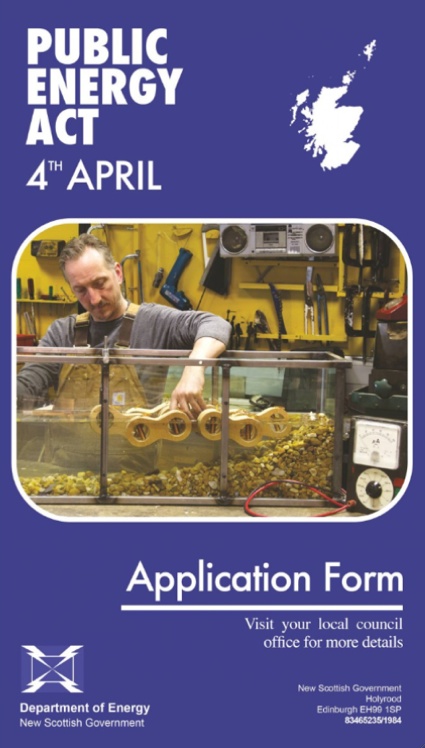 Could you explain the various ‘inventions’ you were showing at the RCA exhibition?
Could you explain the various ‘inventions’ you were showing at the RCA exhibition?
The first ‘invention’ is the creation of a home workshop inventor. Its basis is the Salter Duck developed in the 70s and early 80s by the scientist, Stephen Salter, at Edinburgh University. It takes the form of an energy harvesting wave machine. The picture shows the inventor in his workshop, working on the device. He received funding through the Public Energy Act 1985 from the Sovereign Wealth Fund. This Act was a means of creating the start of a personal energy infrastructure for the people of New Scotland. In our contemporary real world we see this more and more: the installation of solar panels, geothermal heat pumps and windmills. The Act was also a way for creative invention to take place following the repeal of energy intellectual property rights the year before.
By the year 2000, the New Scottish Government wants to halt conventional nuclear energy production. It also launches the “Third Millennium Prize”. This is analogous to the Longitude Prize of the Eighteenth Century, where the government of the day tried to resolve one of the crucial impediments to progress of the time, the ability to travel across the oceans safely and directly. I also had in mind John F Kennedy’s address at Rice University in Houston, Texas where he spoke passionately to the American people about the need to succeed in sending the first men to the moon. These were projects of national importance or pride.
In New Scotland, there is decreasing dependence on nuclear energy following the implementation of other energy creation/transformation methods. However, much of the rest of the world still needs access to substantial, sustainable and uninterrupted energy sources.
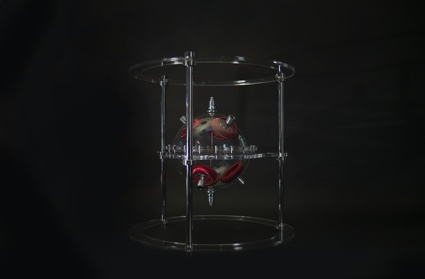
The ‘fusion reactor’ is the culmination of research started in 2000, when New Scotland becomes the global hub for fusion research. This is backed by the Sovereign Wealth Fund, of course, enabling the research to flourish. Ultimately, as is often the case, a serendipitous scientific discovery creates a breakthrough illustrated by the fusion reactor pictured. In this instance research is encouraged by a hothouse environment not unlike Silicon Valley, but where intellectual property is no longer a barrier.
Government funded mega projects are not new. We’ve had many countries collaborate on a number of different fusion projects, and the European Space Agency, the ISS, CERN, NASA are all centrally funded by combined or single governments.
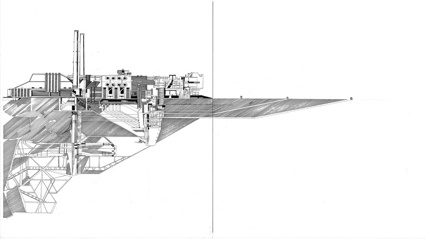 Lochgelly Geothermal Mineworks. Drawing by Dimi Constantinides
Lochgelly Geothermal Mineworks. Drawing by Dimi Constantinides
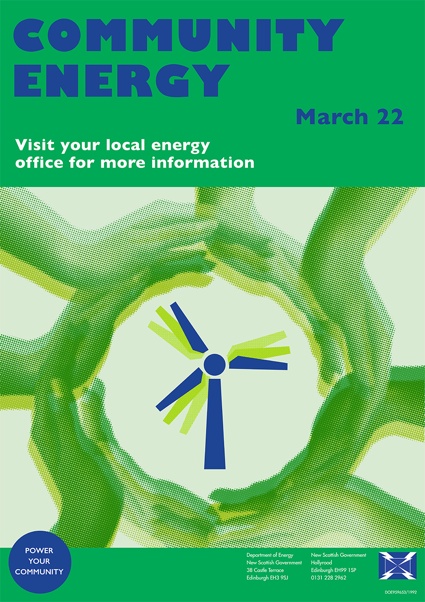 Poster Community Energy Act 1992. Assisted by Esa Matinvesi
Poster Community Energy Act 1992. Assisted by Esa Matinvesi
In 1992, people realized that they could use the existing mine works, abandoned in the 60s, to generate geothermal heat in order to heat the town and provide the resources required to create new industry. How would that work? How can an abandoned mine provide energy?
I wanted to look at different scales, from the personal (Public Energy Act 1985), to the global (Third Millennium Prize 2000). The Community Energy Act 1992 made possible the implementation of intermediate sized, community wide energy infrastructures. What could happen if communities with a shared past, interest or skills were encouraged to work together?
Lochgelly is a former mining town in Fife, in Eastern Scotland. When coal mining stopped in the 60s, the town and its citizens were largely forgotten. Overlooked and existing infrastructures were important. How could we repurpose what we had already created? I wanted to explore the use of geothermal heat within the old infrastructure of the coal mines.
Geothermal heat pumps work on the same principle as our refrigerators, but in reverse. They take advantage of the constant temperature of the earth from 6m to over 100m below the surface. Cold water is pumped down and returned to the surface to have the geothermal heat extracted. Geothermal power can is an excellent source of hot water, which could in turn open the town to the possibilities of different types of industry. Food processing or the hotel trade for example both require huge amounts of hot water which the mines could produce in abundance. The possibility for extracting energy from other infrastructures also exists. True geothermal energy could be extracted from abandoned oil wells which regularly bore several kilometres through the earth. Perhaps disused fishing fleets could be retrofitted with wave energy devices allowing them to become floating electricity generators.
This element was also examining the relationship we have to energy in another way. We are so used to having electricity come to us from distant power stations, why not create infrastructures where people go to the sources of energy. It then opens a new set of questions: are cities abandoned and the countryside re-inhabited? Collaborations with architects and vehicle designers come to mind.
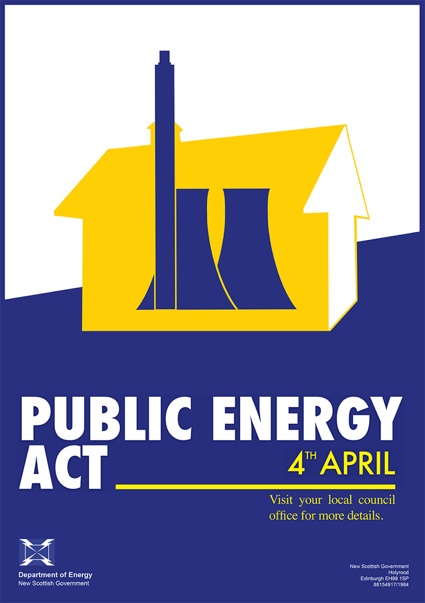 Poster Public Energy Act 1985. Assisted by Biin Shen
Poster Public Energy Act 1985. Assisted by Biin Shen
I was very surprised by the Energy Intellectual Property Rights Act 1985 which would remove intellectual property rights for energy technologies. This is obviously very seducing but i don’t see many signs nowadays of intellectual property rights being lifted. Why would it have been different in 1985?
You’re quite right. This is a surprising step for a fledgling country. I didn’t want to make this project a whole series of spectacular implausible revolutionary actions. That would have made the counterfactual story lose any element of believability, but this is bold move with perhaps just enough basis in fact to push the scenario forward.
The formation of free and open software pioneer, Richard Stallman’s real life GNU Project in 1983 is a development that bleeds into the timeline of the New Scottish Government. They realise that independence from corporate control can encourage the development of technologies much faster than when they’re chained to copyrights and patents. Open collaboration is the key.
The background was the concept of a shared human destiny found within alternative publications such as The Whole Earth Catalog or Mother Earth News. Stores such as Real Foods in Broughton Street in Edinburgh, were established in the mid-70s and promoted open, environmentally sustainable living which go hand-in-hand with the beliefs of organisations like Greenpeace and Friends of the Earth.
Many believe that ideas are the property of humanity and they belong in the public realm, Sir John Sulston versus Craig Venter on DNA sequencing and exploitation, for example. Even Plato and Aristotle held differing views on the nature of property and ownership. A government whose major concern is the development of sustainable energy and energy independence would be more likely to also see the benefit of a greater distribution of knowledge. The New Scottish Government realise the importance of this wider, generational thinking and pushed through the implementation of this Act.
I had planned to have the Energy Intellectual Property Rights Act occur much later in the timeline, to reflect a wider public debate, but as it’s so critical to the development and ethos of sharing, it had to happen as soon as possible after the creation of New Scotland.
Today, intellectual property rights are contingent on the creation of profit and the promotion of capitalism. This means keys technologies can be tied up for years making further developments take even longer.
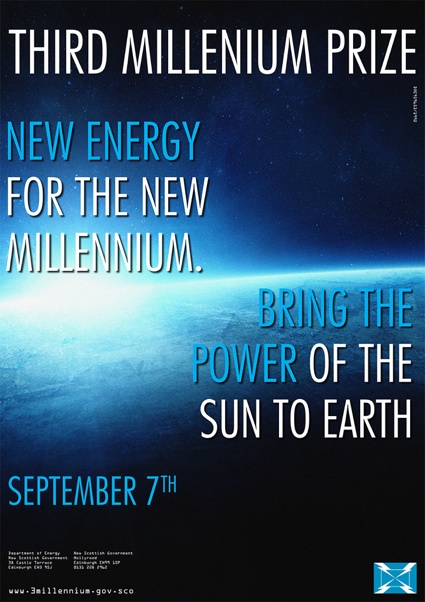 Poster Third Millenium Prize 2000. Assisted by Esa Matinvesi
Poster Third Millenium Prize 2000. Assisted by Esa Matinvesi
Are you planning to push the project any further?
The next step is to take the project to V2 Test_Lab in Rotterdam. It has also been picked as a finalist in the RCA Sustain Awards during London Design Festival 2014, which coincides with Scotland’s’ Independence Referendum on September 18th.
I’d like to expand on the economic concerns, the creation of sharing economies within an energy and information peer-to-peer distribution structure and the energy currencies it creates. What happens to conventional economics when rather than trying to store the energy you’ve created, which is difficult at the best of times, you give it away? A different system of values start to play out. Economy changes from our obsession with the accumulation of resources, to one where we share. How do corporations function after 2021 when the Watt starts becoming an established global currency?
The expansion of the timeline is important too, but without making it didactic; there needs to be room for interpretation and discussion. I’d like to leave the prospects of Torness nuclear power station or the different relationship between a wealthy New Scotland and perhaps a weaker less influential England, up to the imagination of other peoples. Would the remains of the Union start adopting the measures pioneered north of the border? All sorts of other questions remain to be explored. How is the new nation affected by migration or by new or old alliances?
Much of this work allies with Frederic Jameson’s paraphrasing of Slavoj Zizek, “It’s easier to imagine the end of the world than the end of capitalism”. This project is really about provoking thinking, about how we can foster alternative political systems which have a truly long term, globally inclusive philosophy. How do we create less damaging economic environments which fit better within our ecosystem, and how to give more exposure to one of the fundamental relationships that makes us human: energy, economics and politics?
Thanks Mohammed!
